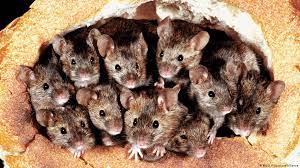As Omicron spreads around the world I asked myself the question, where did such an odd variant come from? While this has not raised the controversy that the original Wuhan strain did (bat vs lab) the question is equally interesting and perhaps, in practical terms, even more important when considering what comes next.

The differences between Omicron and the previous variants are such that it is highly unlikely to have taken place one mutation at a time in humans.
It is as if the Delta variant took a holiday from humanity, went somewhere where immunity and vaccination doesn’t exist, and went through some serious evolution, to then return to us. New evidence suggests this is exactly what happened. That’s where mice come in.
Mice
Mice are everywhere. Within 500 meters of where I’m typing, they live and breed in holes under grass tufts, the base of trees, in sheds, in my allotment, in my loft – they are everywhere. They cause me little trouble but do occasionally eat my carrots and beetroots, but they also feed the local owls, buzzards and any other wildlife that can catch them and are an important part of any ecosystem.

Evidence of their activity is almost anywhere you look. Despite my efforts to keep them out of the house they nibble my pipe insulation in the loft and of course, poo and wee as they go.
Wider afield, they are surviving our mild winters in larger numbers, and so the ticks that infect them are spreading up the local estuaries, along with the myriad microbes that infect the ticks. This is testified to by the living experiment which is the numbers of ticks picked up by my dog Zola.
Trying to get rid of mice is simply not possible, indeed undesirable. I see them as another companion rather than a pest – as I feed and encourage birds I celebrate the abundance of rodent life within reason. Like any relationship, balance is needed and in our unbalanced world, mouse populations are increasing across many continents.

Plagues of mice take place when we give them unlimited food, as in this Australian grain store.
It seems Mus Musculus, the common house mouse, have high numbers of ACE2 receptors (the target of the viral Spike protein) and this common feature with humans means they may play a key role in the evolution of the pandemic.
Mice and Omicron
This study suggests that Sars-Cov2-19 has indeed been taking a holiday in mice. They conclude:
“We found that the molecular spectrum of pre-outbreak Omicron mutations was inconsistent with the rapid accumulation of mutations in humans but rather suggested a trajectory in which the progenitor of Omicron experienced a reverse zoonotic event from humans to mice sometime during the pandemic (most likely in mid-2020) and accumulated mutations in a mouse host for more than one year before jumping back to humans in late-2021”
In other words, we infected the mice, they offered the virus unknown trillions of replication events with mutation a possibility every single time, and then, somehow, somewhere, a single mouse passed the infection back to humans. Just a few weeks later Omicron is truly global.
Thankfully, it seems milder, but much of that looks like being due to the protective effect of previous infections and vaccinations. Good initial news from South Africa was tempered by the younger age of the population, widespread previous infections and their summer. Now it seems to be sweeping through populations and those without previous infections or vaccinations are ending up in hospital. Worryingly too, it seems to be increasing hospital admissions in children.
What now?
The immediate implication is that Omicron, right now, is continuing its rapid evolution in mice, and will mutate into many different variants. Most of which will die out, but occasionally one will increase its transmissibility and occasionally one of these will jump back to humans – potentially over and over again.

We’re all in this together!!
It is possible that transmissibility will continue to increase and to a considerable extent that means immune evasion. My hope is that this will mean ever diminishing virulence as the variants in circulation become ubiquitous and most of us continue to develop our immunity, as with other coronaviruses, with vaccines against variants which threaten the health of vulnerable groups of people.
However this is far from guaranteed. There are huge uncertainties as to how the virus could evolve and mice may well develop immunity to variants which will harm us. Yet I’m hoping that perhaps a nasty variant will rapidly kill local mice colonies and not spread, while more transmissible though less harmful variants will do well and then (inevitably) jump back to us. In which case mice will be doing us a big favour. This might be wishful thinking – we will find out this year.
Till then the message is of one of our total interconnectedness with the world around us. Fingers crossed for the next variant and the endless variants after that.
Despite this, I still have affection for mice. Their growth is simply showing us that their success is our failure – in a warming, predator depleted world they are doing well, we are doing badly.
Beyond the ticks, fleas, (and their bacteria and viruses) carried by mice (and other rodents) that is the far bigger and far more important message.
Thanks once again for reading the blog, if you have any feedback at all, do leave it in the box below, and till next time I wish you all the best possible health!